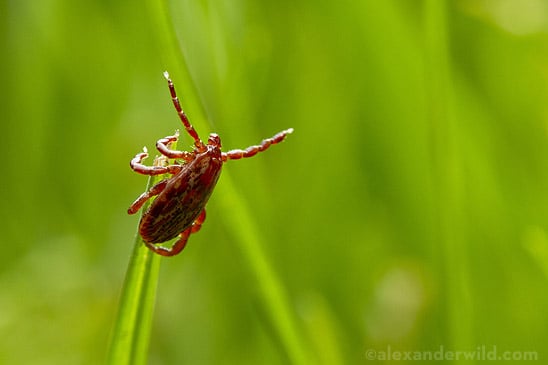
By Hannah Staab
In order to survive, ticks constantly struggle to balance their two vital resources: blood and water. However, a tick’s maintenance of blood and water are in direct competition with one another, forcing the ticks’ behaviors to shift back and forth in an inefficient manner. Ticks need three blood meals to provide nutrients and energy, promoting development from larva to nymph to egg laying adults. To obtain a blood meal, ticks quest from the top peaks grasses and leaves, latching onto any potential host that passes. Ticks also need to sustain a healthy water level to stay alive. To ingest water, ticks don’t drink like we do; their bodies absorb water by extracting water vapor from the atmosphere while they are closer to the ground.
Consequentially, the priorities of blood and water are in direct conflict, one requiring the tick to be on the ground, and the other prompting the tick to climb to the highest perch possible. In addition to luring the tick in the opposite direction of water, waiting for hosts on top of long strands of grass also exposes the tick to the sun and drier air, causing dehydration. Uninfected ticks spend most of their time trying to balance these two needs, absorbing water while they are on the ground, climbing up to the tips of vegetation while looking for hosts, then returning to ground level when they start dehydrating. However, for ticks infected with the Borrelia burgdorferi bacterium, which causes Lyme disease, their priorities shift in favor of finding a blood meal.
It is not unexpected then that a vector-borne disease such as Lyme interferes with the behavior of the vector. When other disease vectors such as mosquitoes, sand flies, and tsetse flies are infected with a pathogen, the presence of that microbe in their bodies alters their behavior to make them bite more frequently, and aim to bite more people. The behavioral changes in mosquitoes, ticks, and other disease vectors can all be explained by the pathogen’s drive to find a host and reproduce as much as possible. In the case of the tick, the Borrelia burgdorferi bacterium manipulates the metabolism, and maybe even the expression of certain genes, to amplify the tick’s impulse to search for blood meals, and silences its drive to return to the ground for water.
More research is needed to understand how the bacterium causes these behavioral changes, but it is possible that the bacterium’s presence modifies the function of certain tick genes involved in metabolism, which has been shown for another pathogen called Anaplasma. Current studies on this topic have revealed that uninfected ticks pursue humid areas for host-seeking and to help satisfy their water needs, choosing areas with about 80% relative humidity. However ticks infected with the Lyme bacterium preferred areas with 70-75% relative humidity, and also chose higher questing positions, showing that they are more tolerant of water loss, and are not as heavily impacted by dry conditions. The Lyme bacteria can even change physical features of the tick, with infected ticks having a bodily fat content 12.1% higher than uninfected ticks. By causing this physical change, the bacterium confers on the tick more energy reserves so it can spend a longer time climbing vegetation and searching for a host.
The Borrelia burgdorferi bacterium causes a series of metabolic adaptations that allow the infected tick to prioritize finding a blood meal over maintaining a certain water balance. These adaptations have also made infected ticks more suited to survive the challenging weather conditions that will come with climate change. Along with increasing temperatures, some areas of the globe are projected to become significantly drier. Therefore when tick populations encounter these warmer weather conditions, the Lyme bacterium will make them hardier and more likely to survive. It is possible that areas experiencing hot and dry conditions will have a higher density of infected ticks, and therefore increased the risk for humans to contract Lyme disease. The intersection of infection, tick behavior, and climate are all factors we need to be conscious of when we consider Lyme disease awareness.
For more on Lyme disease and climate change, click here.

GLA
Admin at GLA
